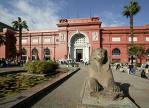
The present Egyptian Museum was designed in 1896 by the French Architect Marcel Dourgnon in the neo-classic style that suits the ancient and classical monuments, but does not compete with the still standing ancient Egyptian architecture.
The inside galleries are spacious and the walls are high. Natural light comes from the diffused glass panels on the ceiling and from the windows of the first floor. The middle atrium is the highest part of the museum where the monuments were installed as in ancient Egyptian temples. The T-shaped plan of the building took into consideration any future enlargement and met the requirements of an easy flow of visitors from one gallery to another.
The artifacts are distributed in two main floors. The lower one contains the heavy monuments such as stone sarcophagi, statues, stelae, and wall reliefs. The upper floor contains the thematic exhibits: manuscripts, statues of deities, royal mummies, objects of daily life, mummy portraits, unfinished sculptures, Greco-Roman statuettes and vases, and artifacts of the afterlife, among others.